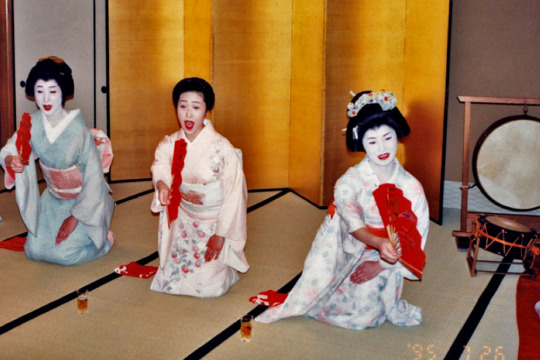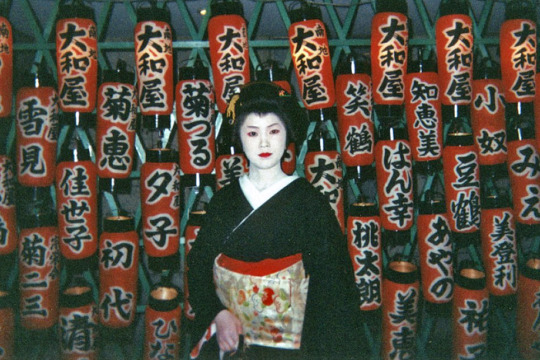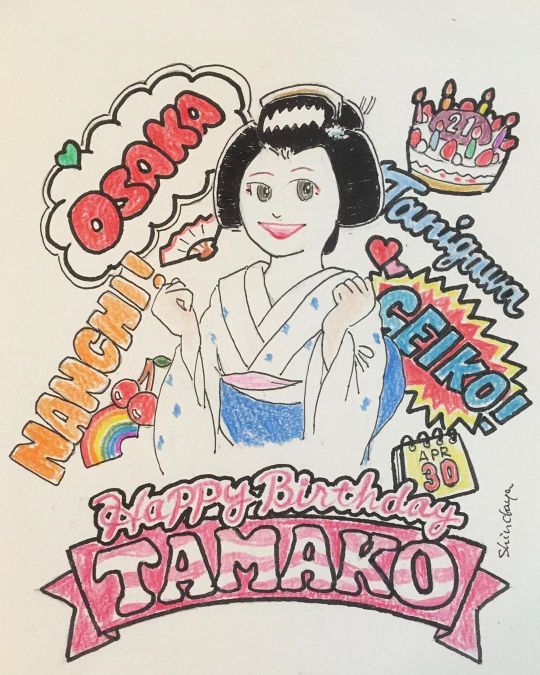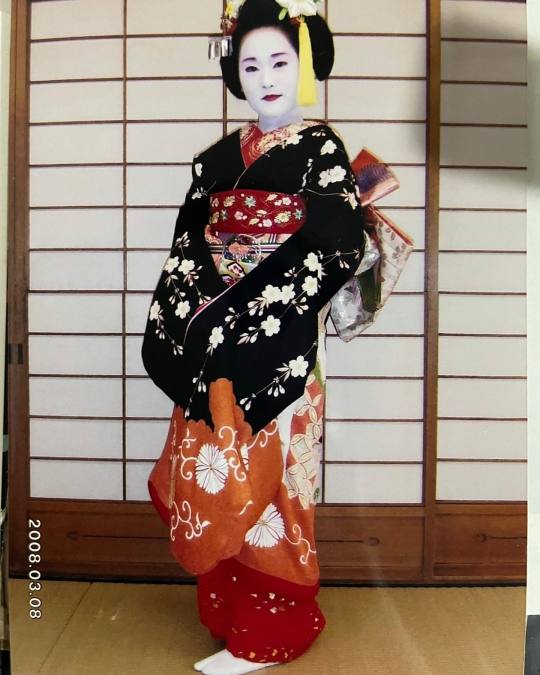#osaka geiko
Text





Osaka-Nanchi Geiko and Maiko in the 90's.
The lady who posted these pictures on her blog became a Geiko in the early/mid-90's at the age of 26 in Yamatoya 大和屋 Okiya. After becoming mother, she continued to work as part-time Geiko until 2014.
Yamatoya was established in 1910 and became one of the more famous Okiya in Soemon-chô. In later years, it was a Ryotei until closing its doors forever in 2003.
As of 2024, five Geiko work in Nanchi. They debuted from the only Okiya in this district, Tanigawa たに川.
89 notes
·
View notes
Text
Two Osaka Geiko 1910s

Two geiko (geisha) from Osaka, possibly Kitashinchi hanamachi. Asachiyo on the left.
3 notes
·
View notes
Note
Hi! Lately, I have been very interested in Maiko/ Geiko and Yujō/Oiran/Tayū culture, their differences, but the most popular known books, documentaries have so many lies and discrepancies. I hope you might know some answers.
I don’t know if you read “Autobiography of a geisha” by Masuda Sayo, but she described her life as a hot-springs geisha during W2. While she learned “gei” (art), what happened to her was truly not different from prostitution. She was given different points after sleeping with men depending whether he was her danna, someone else’s danna or just a random guy.
There is this whole thing about American soldiers thinking “geisha” meant “prostitute”, bc some of the prostitutes decided to dress as geisha to attract more customers, I suppose?
Then, what Americans thought wasn’t exactly wrong (if we are not looking at Kyoto or Osaka)? Or was Masuda Sayo just a prostitute and she herself didn’t even know about it?
Are geisha outside of major districts (idk how to call them, Ponchoto, Gion Kobu etc) not considered geisha? Were times just so difficult that geisha had to resolve to prostitution under a banner of love instead of money, so it doesn’t make it illegal? Did Masuda just lie?
Masuda Sayo wrote the book herself in freaking Kanji, I believe her more than what “foreigners”, who only lived in geisha district for a couple of months, managed to understand. And Mineko Iwasaki was a queen among the geisha of completely different time period. I am more curious about how life was for “third rate” geisha.
I guess I am just somewhat confused about the statement that “Geisha are not prostitutes”, while there is an account that poor country girls sold in shitty okiyas were in fact as good as prostitutes.
In specific areas of Japan there used to be "double registered" geisha; that is, they were registered by the government to work as both geisha and as prostitutes. However, there were areas that worked under these double registration rules but didn't have official registration, so pretty much anything went. Sayo Masuda worked in one of those areas. These areas were often in small seaside towns or resort villages, which lead to onsen geisha having a tainted name that endures to this day. What they considered a geisha may as well have been night and day from what was going on in the large cities that had proper geisha associations that actually looked out for their members. This isn't to say that districts like Gion Kobu or Pontocho were perfect as at the time that Masuda was active young girls were still being sold into the karyukai across the country. So, where geisha populations were large and in larger cities they were primarily just geisha who, by government law, could not engage in prostitution. However, in small towns and villages, those who were identifying themselves as geisha also often took part in prostitution on the side as it was sadly a way for them to "serve" their customers. Sayo Masuda also wrote her autobiography in hiragana, not kanji, as she couldn't read or write kanji since she never had a formal education.
American GIs brought back stories of "geesha girls" due to women who were not geisha but used one of the only Japanese words that they knew to have sex with for money in order to survive after the war. The Americans had no idea what a real geisha looked like and the karyukai didn't reopen (if they weren't bombed to shreds) until 1947. So, there were two years of regular women calling themselves geisha having sex with GIs that really didn't help with the Western perspective of geisha.
By the time that Mineko Iwasaki came along, which was decades after Masuda was active and the Americans had mostly pulled out of Japan, prostitution had been made illegal across the country, so no double registered geisha existed anymore and no geisha anywhere were supposed to be having sex on the side for money (sex on the side is fine as long as it's consensual between two adults and no money is being exchanged though). Since geisha are incredibly exclusive for the most part, it's far cheaper and easier to hire a call girl or a hostess if someone wants to have illegal sex in Japan (it would be naïve to say that it doesn't happen even though it's illegal).
So, were there different "levels" of geisha when Sayo Masuda was active? Of course. Was she lying? I don't believe so. Her story is extremely compelling and detailed to the point where it would be hard to be made up. Were the lines blurred on what was a "geisha" prior to World War II? Depending on where you were, yes. Has the karyukai changed drastically since that time? Very much so. Is there still work to be done when it comes to how geisha are perceived both inside and outside of Japan? Indeed, there's quite a great deal. But, we all have to start somewhere and I hope that this has helped to answer your questions ^^
63 notes
·
View notes
Note
Was hijikata married? Or he had lover before?
Hijikata was never married, but he had many lovers.
Even in his earlier years in Edo, he frequented Yoshiwara and had a woman there (source). He wrote the poem:
The way of love
If you know it, you are lost
If you know it not, you will not get lost
(And then crossed it out, probably out of embarrassment) 😅
When he was 17, he got into a relationship with a maid at the kimono shop where he worked. She became pregnant, but he broke up with her after giving her money. (source)
He did have a fiancee named Koto who was the daughter of a shamisen shop owner, but he left for Kyoto before they could marry. He sent her a present and visited her whenever he was in Hino. She waited for him to return home, but he broke up with her when he went back for a visit in 1867 (He kept her waiting for 4 years...) (source)
Here's more info about it: (source)
Tamejiro, Toshizo’s eldest brother, enjoyed playing the shamisen, so he went to a shamisen shop owned by a distant relative of Sato Hikogoro. Okoto was a beauty with a good reputation in the neighborhood, and Toshizo liked her so much that he and his relatives discussed the possibility of marriage. However, Toshizo said, “I want to become a samurai and make a name for myself. Therefore, I cannot have a family here and now. I want you to let me be free for a little while longer”. Perhaps still harboring lingering feelings for the beautiful Okoto, Toshizo left for Kyoto with the meaningful poem, "The way of love, if you know it, you are lost; if you know it not, you will not be lost”. It’s said that Okoto could not give up on Toshizo and remained unmarried for the rest of her life. As an aside, it’s said that Hijikata went to see Okoto when he returned to his hometown in Keio 4 (1867). It’s not known what they talked about.
While in Kyoto, he was very popular with women and he had a colorful life with the oiran and geiko. I remember reading that he had 6 mistresses at the same time, but I can't find the source. Another source says that he didn't take any of them as mistresses.
He once sent home a pile love letters that he had received, along with a letter where he lists many women from the red light districts, probably attempting to attract more recruits. He wrote:
By the way, although we strive to serve our country faithfully and patriotically, I am attracted to women in ways I cannot describe with a brush. For example: in Kyoto, in Shimabara, there’s Hanagimi-tayu and Ichino-tenjin; in Gion, there are about three so-called geiko; in Kitano, there are the maiko Kimigiku and Koraku; in Osaka, in the Shinmachi district, there’s Wakazuru-tayu and two or three others; and in Kitano, in the Shinchi district, the number is so large that I’ll run out of ink if I listed them all. Imagine that!
Women make me forget to do my best for the country.
Toshizo has gone astray!
Here's more info about it: (source):
During his time in the Kyoto Shinsengumi, Toshizo was a good-looking man, so he also had many love affairs and proudly sent home love letters he received from many prostitutes to Kojima Shikanosuke. First, he wrote about Hanagimi-tayu (花君) and Ichino-tenjin (一元) in Shimabara, three geiko in Gion, Kimigiku (君菊) and Koraku (小楽) in Kitano, and Wakazuru-tayu (若鶴) and three others in Osaka Shinmachi. He is said to have had affairs with 12 women during his time in Kyoto. However, he did not take them as his mistresses like Kondo and the other executives, but rather parted with them cleanly. However, Sato Toshinobu, Toshizo’s nephew, visited Kyoto in 1887 and found out that Kimigiku, who lived in the Kamishichiken district outside the east gate of Kitano Tenjin, gave birth to Toshizo’s baby girl, but the baby died prematurely, and Kimigiku married someone else but eventually died.
Kondo once wrote in a letter that the Vice-commander was bragging about his numerous women. In addition, many of the higher ranking members had more than one home in Kyoto where they kept their lovers. Hijikata was said to have been the worst offender in this regard. (source)
After returning to Edo, he was still very popular with women:
The Shinsengumi spent in Goheishinden just after Kofu. Hijikata spent some of his time fishing in the river there, while still using the name “Naito Hayato”. No one in the area knew that he was actually Hijikata Toshizo of the Shinsengumi, so his reputation was not an influence on what happened next. Before long every girl in the village had gathered on the riverbank to watch the “handsome samurai”. It was agreed by all of them that he was “a nice man”. (source)
It seems that some time after that, he stopped having relationships with women:
By the time Hijikata went to Ezo, he was avoiding women altogether. As far as anyone knows, he had no children. (source)
If you want to read more about the Shinsengumi's love lives, you might be interested in the posts translated from Shinsengumi Koiuta. There are many interesting stories.
46 notes
·
View notes
Text
Demon Slayer: Kimetsu no Yaiba Kizuna no Kiseki Soshite Hashira Geiko e , After the Fever, Kamen Rider 555 20th: Paradise Regained, Omuro-ke dear sisters, Tsumi to Aku, Kamisama Matte! Ohana ga Saku kara, Japanese Film Trailers
Welcome to the first trailer post of the week
Come back for the next one tomorrow
I’m late on doing these because I have been writing synopses for the Osaka Asian Film Festival 2024. It was intense but rewarding and I’ll be cranking up coverage over the next few months so stick around! I’m excited to get into the details!
In terms of games, it’s still Bravely Default. Over the course of a month…
youtube
View On WordPress
#After the Fever#Demon Slayer: Kimetsu no Yaiba Kizuna no Kiseki Soshite Hashira Geiko e#Japanese Film Trailers.#Kamen Rider 555 20th: Paradise Regained#Kamisama Matte! Ohana ga Saku kara#Omuro-ke dear sisters#Tsumi to Aku#Youtube
0 notes
Video
Osaka Maiko Chiyoha 1911 por Blue Ruin 1
Por Flickr:
Teruha debuted in the Shinbashi geisha district of Tokyo in 1911, but prior to that she was a maiko (apprentice geisha) by the name of Chiyoha in the Sōemon-chō geisha district of Osaka. She debuted in Osaka in 1909, after several months training as a minarai (watching apprentice), having been sold into the flower and willow world aged 12 years. To increase her commercial value, Chiyoha was dressed in the Kyoto style with a Kyōfu hairstyle and a darari obi.
#Osaka Maiko#Apprentice Geisha#Geiko#Geisha#Maiogi#Dancing Fan#Tsuru#Cranes#Kanzashi#Japanese#Japan#Meiji Period#1911#Postcard#Chiyoha#Teruha
30 notes
·
View notes
Photo

#おえかき #おえかきぐらむ #illustration #illust #イラスト #絵 #geiko #geisha #玉幸 #たまたみ #南地 #nanchi #osaka #ころなにまけるな https://www.instagram.com/p/B_nJ4KVgHgr/?igshid=9vh7korkyx4m
1 note
·
View note
Photo

英会話の練習をする大阪・大和屋芸妓(げいぎ)学校の芸者たち=1951年ごろ、大阪・宗右衛門町
147 notes
·
View notes
Photo



A Gathering of Osaka Geiko 1910s. A gathering of prominent geiko (geisha) from Osaka, together with their instructors and/or patrons. Including some of the most famous geiko of the late Meiji period (1900-1912): Tondaya Yachiyo I, seated far right holding a flower; Masaya, seated far left; and Toyoko, standing behind her to the left. Text by Blue Ruin 1 on Flickr
189 notes
·
View notes
Video
<strong>Osaka Geisha 1900 (1) <a href="https://www.flickr.com/photos/blue_ruin_1/">by Blue Ruin 1</a></strong>
Geiko (geisha) Koteko of Osaka holding a hago (shuttlecock) and hagoita paddle (battledore).
4 notes
·
View notes
Text


Kitashinchi Geiko (I think her name was Sakura さく良), recreating the look of Kitashinchi Maiko. She explains that the outfit (Hikizuri, Haneri, Obi, Obidome) was worn by her older sister Umetomi 梅十三 when she was a Maiko (1950's). The hairstyle she is wearing in the pictures is in Kyoto-style. When Kitashinchi still had Maiko, their hairstyles were either Kyoto or Edo style (it seems the bin 鬢, the round sides of the hair, are the difference here).
83 notes
·
View notes
Text
A Gathering of Osaka Geiko 1910s

A gathering of prominent geiko (geisha) from Osaka, together with their instructors and/or patrons. Including some of the most famous geiko of the late Meiji period (1900-1912): Tondaya Yachiyo I, seated far right holding a flower; Masaya, seated far left; and Toyoko, standing behind her to the left.
2 notes
·
View notes
Note
Hello Missloko. Hope you are well! I wondered if you had seen posts by megumu_tanigawa and kotone.105 of a person who looks very similar to now retired Maiko Ryoma? Is she debuting in Osaka as a Geiko?
She's Osaka's newest geiko minarai named Fukuzuru (福鶴), but she is not former maiko Ryoma ^^
7 notes
·
View notes
Photo

Oiran Skater Girl!🛹 Shinmachi, the home of Nama Tease, and the traditional Oiran District of Osaka.👘 T-Shirt @namatease.osakajapan FREE WORLDWIDE SHIPPING Available at namatease.com #namatease #tshirt #blacktshirt #japanesestyle #fashion #streetfashion #streetwear #streetstyle #japan #japanese #tees #teeshirts #graphictees #onlineshop #japanesetshirt #oiran #geisha #maiko #geiko #kimono #obi #geta #skate #skateboard #skateboarding #longboard #longboarding #skatergirl (at Shimmachi, Nishi-ku) https://www.instagram.com/p/CAl6aiDAUY3/?igshid=jsa56joql2eq
#namatease#tshirt#blacktshirt#japanesestyle#fashion#streetfashion#streetwear#streetstyle#japan#japanese#tees#teeshirts#graphictees#onlineshop#japanesetshirt#oiran#geisha#maiko#geiko#kimono#obi#geta#skate#skateboard#skateboarding#longboard#longboarding#skatergirl
10 notes
·
View notes
Video
Tokyo Hangyoku - Osaka Maiko 1914 por Blue Ruin 1
Por Flickr:
A hand-coloured postcard of a hangyoku (young geisha) dressed in the Tokyo style of the early Taishō period (1914), with an inset photograph of the same geisha as a maiko (apprentice geisha) from Osaka. At this time, many of the top geisha working in Tokyo were recruited from Osaka, including Teruha and Hamayū.
#Hangyoku#Young Geisha#Geigi#Geiko#Geisha#Osaka Maiko#Gifu Lantern#Hand coloured postcard#Japanese#Japan#Taisho Period#1910s
18 notes
·
View notes


